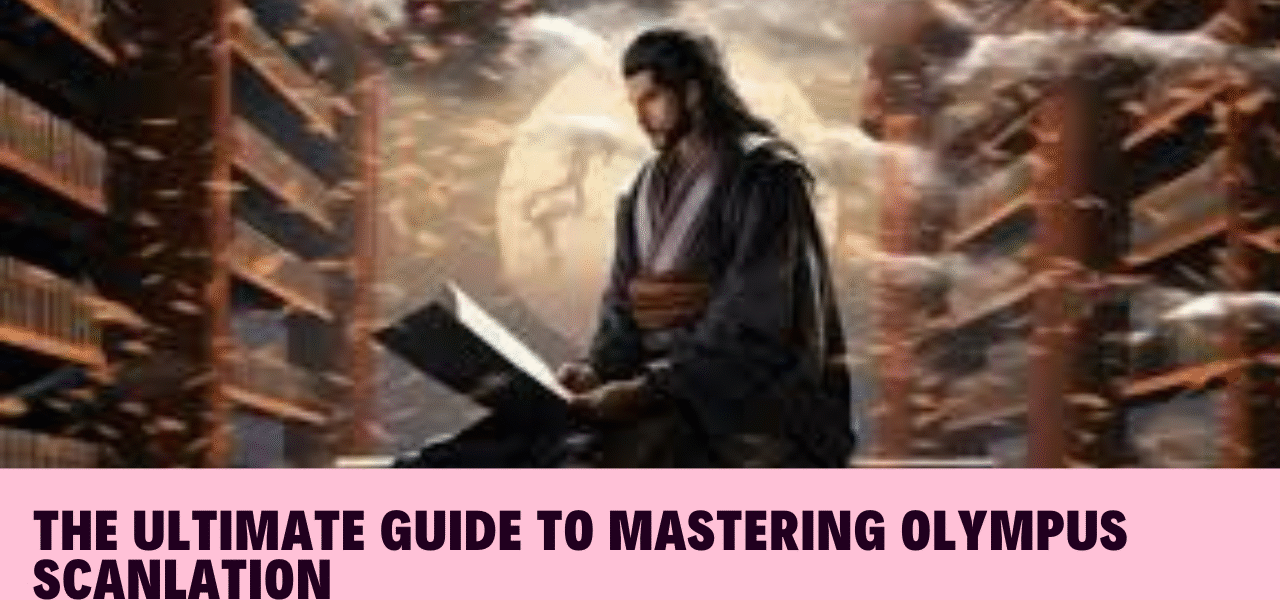Welcome to the fascinating world of Olympus Scanlation! If you’re a fan of manga, chances are you’ve stumbled upon scanlations — those unofficial translations that bring your favorite series to life. Whether you’re an aspiring scanlator or simply curious about the process, there’s so much to explore.
In this guide, we’ll dive deep into every aspect of Olympus Scanlation. From understanding what it really means to participate in this vibrant community, to mastering the tools and techniques required for high-quality releases – we’ve got you covered. Get ready to unleash your creativity and passion for manga as we embark on this exciting journey together!
Understanding Olympus Scanlation
Olympus Scanlation is more than just a term; it’s a thriving community of manga enthusiasts dedicated to translating and sharing Japanese comics with fans worldwide. This practice began as a way to fill the gap for readers eager for content that hadn’t been officially released in their language.
At its core, scanlation involves various stages: obtaining raw scans, translating text, editing images, and compiling everything into a readable format. Each step requires collaboration among talented individuals who bring their unique skills to the table.
The beauty of Olympus Scanlation lies in its accessibility. Anyone passionate about manga can jump in — whether you’re an artist, translator, or editor. It fosters creativity and innovation while allowing members to hone their craft alongside fellow aficionados.
Tools and Software for Scanlation
When diving into Olympus scanlation, having the right tools is essential. A good starting point is image editing software like Adobe Photoshop or GIMP. These programs allow for effective cleaning and manipulation of manga pages.
For OCR (Optical Character Recognition), tools such as ABBYY FineReader can be invaluable. They help extract text from images, streamlining the translation process significantly.
Additionally, consider using translation software like Google Translate for initial drafts. While it’s not perfect, it provides a foundation that you can refine later.
Typesetting requires precision; programs like Manga Studio or Clip Studio Paint excel in this area. They provide features tailored specifically for comics and manga layouts.
Collaboration tools such as Discord or Slack keep your team connected throughout the project lifecycle. Communication enhances productivity and ensures everyone stays on the same page—literally!
How to Obtain and Edit Raw Manga Scans
Obtaining raw manga scans is the first step in the scanlation process. The most common method involves searching for high-quality sources online. Websites and forums dedicated to manga often share these files.
When downloading, prioritize resolution and file type. PNGs or TIFFs generally provide better quality than JPEGs. Keep an eye out for groups known for their clean releases.
Editing raw scans requires specific software like Adobe Photoshop or GIMP. Begin by cropping unnecessary borders and adjusting brightness or contrast levels as needed.
Next, remove any text bubbles using the clone stamp tool or healing brush function to prepare the page for translation.
Ensuring that each page maintains its original feel is crucial during this phase. Pay attention to detail; imperfections can distract readers later on when they dive into your scanlated work.
Translating Japanese to English for Scanlation
Translating Japanese to English for scanlation is both an art and a skill. It’s not just about converting words; it’s about capturing the essence of the story.
Understanding cultural nuances is crucial. Certain phrases may carry meanings that don’t translate directly. A good translator adapts these expressions to resonate with an English-speaking audience while retaining the original tone.
Familiarity with manga tropes and idiomatic expressions helps bridge gaps in understanding. Context plays a vital role, so knowing character backgrounds enhances translation accuracy.
Collaboration with native speakers can enrich your work significantly. They might offer insights or corrections that elevate your translation from good to exceptional.
Always keep readability in mind. The goal is to make dialogue flow naturally, ensuring readers stay immersed in the narrative without feeling jarred by clunky phrasing or awkward syntax.
Typesetting and Cleaning Techniques
Typesetting is a crucial step in the scanlation process. It gives your manga its polished look. The right fonts can enhance readability and capture the essence of the original artwork.
Start by choosing appropriate font styles. Use clean, easy-to-read options for dialogue and narration. Experiment with different sizes to match speech volume or emotional tone.
Cleaning scans involves removing imperfections from raw images. Tools like Photoshop are essential here. Utilize the healing brush to fix blemishes, and adjust brightness and contrast for clarity.
Don’t overlook bubble placement during typesetting. Position text within speech bubbles carefully, ensuring it flows naturally with the art style without overcrowding.
Pay attention to alignment as well; centered text often looks more appealing in manga format. A balanced layout contributes significantly to the reader’s experience while maintaining artistic integrity throughout your work.
Quality Control and Release Formats
Quality control is a cornerstone of successful Olympus scanlation. It ensures that every release meets high standards before reaching fans. This process involves multiple checks, including proofreading translations and verifying image quality.
Different release formats cater to various audiences. Some prefer PDF for easy reading on computers, while others opt for CBZ or CBR files compatible with mobile devices. Each format has its advantages, depending on user preference.
Additionally, resolution matters greatly in the final product. A higher DPI (dots per inch) can enhance clarity but may increase file size significantly. Striking the right balance between quality and accessibility is crucial.
Team members should communicate clearly about expectations during this stage. Consistency across releases builds trust within your community and keeps readers coming back for more content.
Tips for Building a Successful Olympus Scanlation Team
Building a successful Olympus scanlation team starts with clear communication. Ensure everyone understands their roles and responsibilities from the start. This clarity prevents misunderstandings and keeps the workflow smooth.
Recruit individuals who are passionate about manga and dedicated to quality work. Look for translators, editors, typesetters, and proofreaders who share your vision. A diverse skill set within your team enhances overall output.
Foster a collaborative environment where feedback is welcomed. Encourage team members to share ideas and suggestions freely. This not only improves each project but also strengthens relationships among teammates.
Set realistic deadlines to maintain momentum without overwhelming anyone. It’s essential that enthusiasm doesn’t lead to burnout; balance is key for sustained productivity.
Regularly celebrate achievements, no matter how small they may seem. Recognizing hard work boosts morale and motivates everyone involved in the creative process of Olympus scanlation.
The Legalities of Scanlation
Navigating the legal landscape of scanlation can be tricky. Many creators and fans are passionate about sharing their love for manga, but they often overlook copyright issues.
Scanlators typically work with raw scans, which may infringe on the original artists’ copyrights. This raises questions about unauthorized distribution and fair use. While most scanlations exist to promote works or fill gaps in availability, that doesn’t eliminate potential legal repercussions.
Different countries have varying laws regarding copyright. Some regions may tolerate fan translations more than others, while certain publishers actively pursue actions against them.
It’s crucial to understand that scanlation is not inherently illegal but operates within a gray area. Respecting artists and supporting official releases whenever possible is essential in maintaining a healthy balance between passion projects and legal responsibilities.
Engaging with the community openly about these concerns fosters awareness and encourages ethical practices among aspiring scanlators.
Common Misconceptions About Scanlation
Many people believe that scanlation is simply a way to steal content. While it’s true that scanlation involves translating and distributing manga without official permission, the motivations behind it are often misunderstood. Most scanlators start as fans who want to share beloved stories with others.
Another misconception is that all scanlations are of poor quality. In reality, many dedicated groups invest significant time in perfecting their work. They focus on accuracy in translation and aesthetics in presentation.
Some think that anyone can jump into scanlation without experience or skills. However, successful teams require a blend of talents—translators, editors, typesetters, and artists—all working together harmoniously.
There’s the belief that scanlation harms the original creators financially. Many readers argue that they discover series through fan translations before purchasing official volumes later on. This highlights a complex relationship between fandom and commercial success.
Conclusion: The Power of Community in Olympus Scanlation
The world of Olympus scanlation thrives on community spirit. At its core, this art form is about more than just translating and sharing manga; it’s a collaborative effort that brings people together from all walks of life. Each team member contributes unique skills and perspectives, creating a richer final product.
When enthusiasts join forces to tackle a project, they foster an environment where creativity can flourish. Team members support each other through challenges and celebrate successes as one collective unit. The friendships forged through shared passion often extend beyond the digital realm.
Moreover, the community aspect encourages knowledge-sharing among members. Newcomers learn from veterans while experienced individuals stay in tune with fresh ideas and techniques introduced by newer participants. This cycle of learning not only enhances individual abilities but also elevates the quality of work produced by scanlation teams.
As you dive into your own Olympus scanlation journey or seek out others’ projects, remember that collaboration lies at the heart of it all. Engaging with fellow fans adds layers of enjoyment to this already vibrant hobby—making every page turn feel even more significant in your artistic adventure.





2 COMMENTS